Trigonostigma heteromorpha – Harlequin Rasbora
Trigonostigma heteromorpha was described by Duncker in 1904. The genus name Trigonostigma can be broken down into three ancient Greek words. ‘Tres’ or ‘Tria’ means three, ‘gonias’ means corner and ‘stigma’ means signal. The species name heteromorpha is also derived from ancient Greek and means ‘differently shaped’. A reference to the unusual shape of this species compared to the other members of the genus. We must keep in mind that they were initially described as Rasbora heteromorpha, this name is now one of the synonyms.
Their common name is Harlequin Rasbora or Harlequin Fish.
Description
Trigonostigma heteromorpha or Harlequin Rasbora is a species that has been kept for a very long time. Despite the vast area in Malaysia, Singapore, Thailand, Indonesia and Sumatra, the water in which it is found is relatively constant in composition. It is found in rivers, lakes and rice fields where peat is formed by the large amounts of leaves. This makes the pH low, around 5 to 6.5 with low concentrations of minerals. The GH is under 12, comparable to the black water environments in South America.
The Harlequin Rasbora also does well at higher pH values up to 7.5, but the pH will have to be lowered for successful breeding.
The difference between males and females is fairly easy to see in adult animals. The females show fuller than the somewhat slender males. With the males the black cone on their sides end in a point and ends further forward. With the females the cone on the front is straight instead of rounded.
Rasbora heteromorpha is a school-forming species and must therefore be kept in groups of at least 6, but preferably much more. Not only for the welfare of the fish but also because a large school is much nicer to see, their active behavior contributes to this spectacle.
Diet
The Harlequin Barbel is omnivorous. This means they need both plant and meaty food to stay healthy. You can alternately feed them live/frozen food such as artemia, white and black mosquito larvae, tubifex mysis, etc. In addition, flake food and granules for omnivores. They are not very large fish, so adjust the size of the food to the mouth.
The aquarium
The aquarium should be heavily planten with some swimming space in between. This species prefers slightly dimmed light and a very light current in the aquarium. A dark substrate and some floating plants make their colors stand out better. It is advisable to filter over peat to get the correct water values.
Sexual dimorphism
Please pay close attention when purchasing. The Harlequin Rasbora (Trigonostigma heteromorpha), Glowlight Rasbora (Trigonostigma hengeli) and the Trigonostigma espei are often confused. The difference between these fish can be seen in a number of things. Trigonostigma hengeli is the smallest of the three, the Trigonostigma heteromorpha the largest. Logically, Trigonostigma espei is therefore in between. Trigonostigma heteromorpha has a pink color with a large triangular spot. With Trigonostigma espei and Trigonostigma hengeli, it really has a hockey stick shape. Trigonostigma hengeli has a bright orange line above it, Trigonostigma espei is completely orange.

Breeding Trigonostigma heteromorpha – Harlequin Rasbora
Breeding Harlequin Rasbora differs from the other Rasbora species. While the other Rasbora species scatter the eggs between fine-leafed plants such as Java Moss, the Harlequin Rasbora sticks its somewhat sticky eggs to the underside of plants such as Cryptos and Aponogeton.
In preparation for spawning, the female rubs her belly against the bottom of a leaf. This way the male is invited to participate. Swimming upside down next to the female, he clasped her with his tail fin the moment she dropped her eggs. He fertilizes the eggs with a slight vibration. Harlequin Rasbora will deposit 6 to 12 eggs with a total of about 100 eggs, although nests of 300 eggs can also occur.
Before they start breeding, the water must be soft and acidic, otherwise they will not spawn. If they do spawn in harder and alkaline water, the eggs are often infertile. The pH must be around 6 to 6.5 and preferably filter the water over peat. The ideal temperature for breeding is 28 degrees Celsius. Before spawning you should feed them well with live / frozen food such as Daphnia and mosquito larvae.
Once the eggs are laid, don’t forget to remove the parent. After spawning, the parents see the eggs as a delicious meal. A female can deposit around 80 – 100 eggs at a time.
The eggs hatch after about 18 hours, depending on the temperature. The clear larvae stick to the leaf for 12-24 hours while they digest the rest of their yolk sac. After swimming freely, they can immediately be fed with infusoria or, for example, liquifry. After a day or 7 to 14 you can switch to freshly hatched artemia.
Video
Authors
John de Lange – Kevin
Copyright images
John de Lange
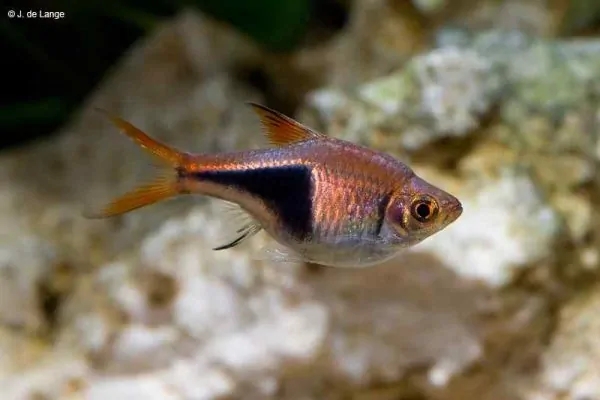



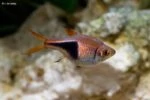

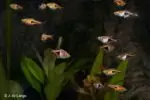
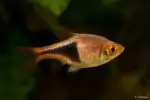
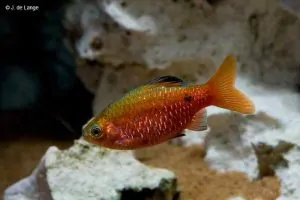


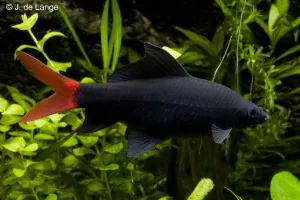



Reviews
There are no reviews yet.